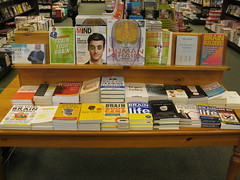| Brain Books 2010 (Photo credit: brewbooks) |
April
is the Month of the Young Child
Eight
Gifts You can Give to your Young Child's Brain
By Sandra Sunquist Stanton
Nothing
brightens my day like a baby’s contagious laugh. We can give them what they
need to be happy, without breaking the bank. April celebrates the young child.
These tips might help you, parents and caregivers, guide your little ones
toward healthy brain development.
1. Security
You create his
world. If he feels safe, he will be willing to try new things. If he is
fearful, he may withdraw, refuse contact and choose to protect himself.
2. Touch
Loving touch
soothes the central nervous system for both you and your child. It communicates
safety and love. Enjoy snuggles, massage, and rocking while reading to her.
These times are short.
3. Fuel Food
His brain doesn't
store the fuel it needs to operate. An infant’s brain uses 70% of his body’s
energy. Every day it needs water, fresh fruit, and omega 3 healthy fats. These
building blocks create and strengthen connections between his 100 billion brain
cells.
4. Music
Both sides of her
brain are active when she enjoys music. It's a workout for her brain. She
forms stronger memories when many parts of the brain are involved.
5. Movement
Your child's
vestibular system coordinates sensory input to send to his brain. Dance, skip,
clap, and let him help you in the kitchen and garden. These activities provide
the movement that gives each experience depth and dimension. His learning
becomes multidimensional, richer and easier for him to remember and build on as
he grows.
6. Reading and
Language
Talking and
reading with your child prepares her for reading and learning. Time with you is
the best way to help her learn language patterns and support early social
development. Does reading the same book over and over again get old? Remember
repetition is exactly what her brain needs to learn.
7.
Rest and Sleep
During quiet
times his brain gets a chance to process his mountain of experiences. When he’s
busy, his neurons are busy taking in sensory information. His brain’s original
cells still need to be connected to one another. That happens during these
breaks.
8.
You!
Enjoy your time
together. Give her face-to-face practice matching your expressions and language
with everyday activities. Electronic media cannot substitute for time with you.
She learns that she matters when you respond to her. Enjoy this together time
and make some memories.
Sandra
Sunquist Stanton Bio:
Sandra
Sunquist Stanton NCC, LPC, BCC, translated, means she is a National and Wisconsin
Counselor and Nationally Certified Health/Wellness and Personal/Life Coach. She
served as school counselor for 25 years and is nearing delivering her 100th
brain coaching program. Her clear descriptions of everyday neuroscience
applications help others find their best lives.

“You can’t get a cup of tea big enough or a book long enough to suit me.” — C. S. Lewis






No comments:
Post a Comment
“I love to read all your comments, thank you!”